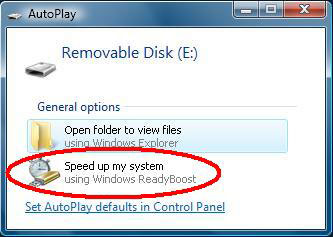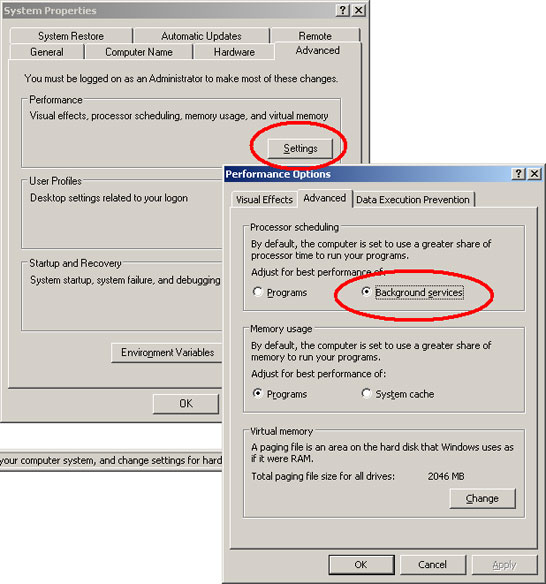Friday, July 26, 2013
Monday, July 22, 2013
Using memory in your storage device to speed up your computer
ReadyBoost can speed up your computer by using storage space on most USB flash drives and flash memory cards. When you plug a ReadyBoost-compatible storage device into your computer, the AutoPlay dialog box offers you the option to speed up your computer using ReadyBoost. If you select this option, you can choose how much memory on the device to use for this purpose.
When you set up a device to work with ReadyBoost, Windows shows you how much space it recommends you allow it to use for optimal performance. For ReadyBoost to effectively speed up your computer, the flash drive or memory card should have at least 1 gigabyte (GB) of available space. If your device doesn't have enough available space for ReadyBoost, you'll see a message telling you to free some space on the device if you want to use it to speed up your system.
You can enable or disable ReadyBoost for a specific flash drive or other removable storage device. For more information, seeTurn ReadyBoost on or off for a storage device.
The ReadyBoost tab lets you decide how much storage space on a removable device to use for boosting your system speed.
Notes
- If your computer has a hard disk that uses solid-state drive (SSD) technology, you might not see an option to speed up your computer with ReadyBoost when you plug in a USB flash drive or flash memory card. You may instead receive the message, "Readyboost is not enabled on this computer because the system disk is fast enough that ReadyBoost is unlikely to provide any additional benefit." This is because some SSD drives are so fast they're unlikely to benefit from ReadyBoost.
- In some situations, you might not be able to use all of the memory on your device to speed up your computer. For example, some flash memory devices contain both slow and fast flash memory, but ReadyBoost can only use fast flash memory to speed up your computer.
10 tips for a faster computer
Audio- and video-based computers thrive on speed, so who doesn't want a faster computer? But you might not need to buy a faster machine if you follow these tips. Most are for Windows XP, but also apply to Windows Vista™.
Turn off the programs that load into RAM on startup. Go Start > Run, type MSCONFIG in the "Open" field, then click on OK. Click on the Startup tab, and uncheck anything that's not essential. Do you really need "iTunes Helper"? Don't be afraid to uncheck functions, as Windows will open anything it really needs.
Optimize USB and FireWire external hard drives for performance. Go Start > Settings > Control Panel. Double-click on System, click on the Hardware tab, and click on Device Manager. Click on the + symbol next to Disk Drives, right-click on your external drive, and select Properties. Click on the Policies tab, and choose "Optimize for Performance" (Fig. 1) There is a tradeoff, though; to avoid potential data loss, use the "Safely Remove Hardware" option in the system tray (the button with the green arrow) when disconnecting the drive.
Optimize internal drives for performance. Follow the same steps as above, but right-click on an internal drive instead of an external one. Select Properties, click on the Policies tab, and choose "Enable Write Caching on the Disk."
Use ReadyBoost. This is the only tip that isn't free, but with Windows Vista you can insert a USB thumb drive (up to 4GB) and when you do, you'll be prompted as to whether you want to enable ReadyBoost (Fig. 2). This adds more memory to your system; it isn't the same as adding more system RAM, but is more like having a really good disk cache. The improvement in speed is noticeable for just about anything other than continuous streaming of data. You do need a fast USB drive; if it isn't fast enough, Windows Vista will notify you that it's not suitable.
 ReadyBoost is a great way for Windows Vista users to speed up data transfers.
ReadyBoost is a great way for Windows Vista users to speed up data transfers.
Be careful about automatic updates. Windows Automatic Update is worth leaving on, as security patches for Internet Explorer are relatively frequent. But some automatic updates essentially take over your computer while they do their job, which can interfere with your work. Most automatic updates have an option where you can ask to be notified of updates, which lets you decide whether to install them immediately or wait. Another option is to schedule updates for when you're not using your computer.
For your audio interface, use ASIO instead of MME or WDM drivers with Sony Creative Software applications. Most interfaces have drivers for all three, but MME and WDM are much slower. And never use any driver that's "emulated."
With ASIO, give priority to Background Services. Sony's programs support the low-latency ASIO protocol, but for best results, go Start >Settings > Control Panel. Double-click on System, click on the Advanced tab, and under Performance, click on Settings (Fig. 3). When the Performance Options window opens, click on the Advanced tab and for Processor Scheduling, choose "Background Services."
 Giving priority to background services helps ASIO work more efficiently.
Giving priority to background services helps ASIO work more efficiently.
Check periodically for new drivers for hardware. New drivers often result in better performance. And don't forget your graphics card; graphics performance often affects audio.
Defragment your drives periodically. This isn't as important as it once was, but a really fragmented drive can slow things down.
Don't disable System Restore. Some people claim disabling System Restore improves performance, but it's worth taking the teeny (if any) performance hit in exchange for being able to return to a restore point when needed.
Use ReadyBoost. This is the only tip that isn't free, but with Windows Vista you can insert a USB thumb drive (up to 4GB) and when you do, you'll be prompted as to whether you want to enable ReadyBoost (Fig. 2). This adds more memory to your system; it isn't the same as adding more system RAM, but is more like having a really good disk cache. The improvement in speed is noticeable for just about anything other than continuous streaming of data. You do need a fast USB drive; if it isn't fast enough, Windows Vista will notify you that it's not suitable.

ReadyBoost is a great way for Windows Vista users to speed up data transfers.
Be careful about automatic updates. Windows Automatic Update is worth leaving on, as security patches for Internet Explorer are relatively frequent. But some automatic updates essentially take over your computer while they do their job, which can interfere with your work. Most automatic updates have an option where you can ask to be notified of updates, which lets you decide whether to install them immediately or wait. Another option is to schedule updates for when you're not using your computer.
For your audio interface, use ASIO instead of MME or WDM drivers with Sony Creative Software applications. Most interfaces have drivers for all three, but MME and WDM are much slower. And never use any driver that's "emulated."
With ASIO, give priority to Background Services. Sony's programs support the low-latency ASIO protocol, but for best results, go Start >Settings > Control Panel. Double-click on System, click on the Advanced tab, and under Performance, click on Settings (Fig. 3). When the Performance Options window opens, click on the Advanced tab and for Processor Scheduling, choose "Background Services."

Giving priority to background services helps ASIO work more efficiently.
Check periodically for new drivers for hardware. New drivers often result in better performance. And don't forget your graphics card; graphics performance often affects audio.
Defragment your drives periodically. This isn't as important as it once was, but a really fragmented drive can slow things down.
Don't disable System Restore. Some people claim disabling System Restore improves performance, but it's worth taking the teeny (if any) performance hit in exchange for being able to return to a restore point when needed.
Sunday, July 21, 2013
Nice qoute....
Sometimes Your Best Feelings Are
Found In The Words Which You
Type ...
But Never Send ... :( ♥
Found In The Words Which You
Type ...
But Never Send ... :( ♥
Subscribe to:
Comments (Atom)













